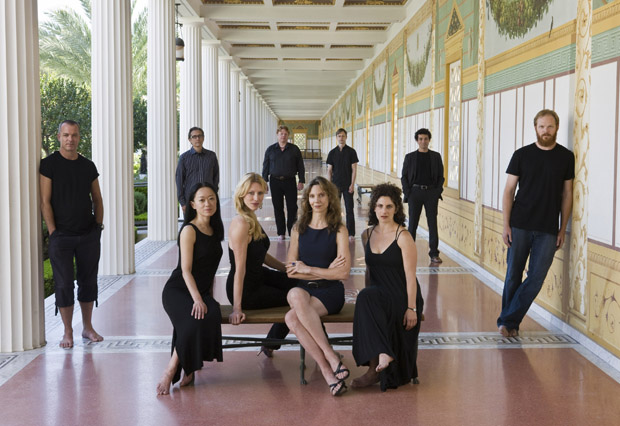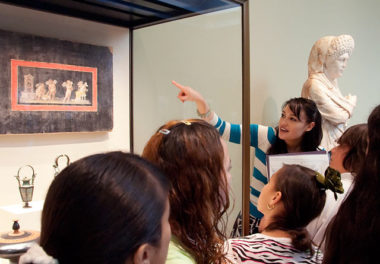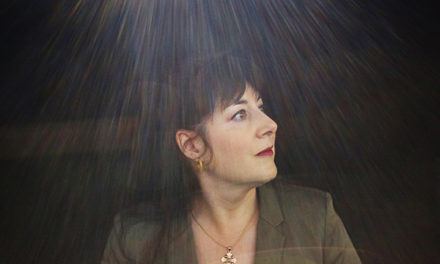First performed over 2,400 years ago, Euripides’ Trojan Women is one of the most enduring and moving of classical dramas—and one of the greatest antiwar plays. Beginning September 8, renowned New York-based theater troupe SITI Company premieres a newly commissioned adaptation of the play at the Getty Villa. This production has a new title, a new text, and a fresh approach.
I talked to Norman Frisch, who oversees the mounting of the Villa’s annual Outdoor Classical Theater production, about the genesis of the SITI adaptation and what audience members can expect to see.
This play is not titled Trojan Woman, but rather Trojan Women (after Euripides). Why?
This isn’t a literal staging of the ancient Greek play. Anne Bogart, the artistic director of SITI Company, approached us with the idea of reimagining Euripides’ action for a contemporary audience. She meant, in essence, using Euripides’ text as a starting point, but imbuing his characters with the sensibilities and souls of 21st-century individuals. The result – which has been very skillfully adapted by playwright and dramaturg Jocelyn Clarke – uses Euripides’ play as a basic framework and then both subtracts and adds to it.

Anne Bogart, artistic director of SITI Company and director of Trojan Women (after Euripides) at the Getty Villa.
What changes did playwright Jocelyn Clarke make to Euripides’ text?
Most noticeably, Clarke has eliminated the large chorus of Trojan women that gives Euripides’ play its name. In Euripides’ text, Queen Hecuba, who has just seen her husband and sons slaughtered and her city of Troy sacked by the invading Greek army, sits at the center of a large number of other widows and mothers who await their transport into slavery and exile.
Clarke’s text for SITI Company focuses much more tightly on the plight of the Trojan royal family. As morning breaks over the smoldering ruins of Troy, only the royal women—Queen Hecuba, her priestess daughter Kassandra, and her two daughters-in-law—remain alive in the palace, detained by the Greek generals who will decide their fates. The three sisters and their mother are onstage together through much of the evening, and each exhibits a very different response to the apocalypse unfolding around them.
In this sense, the SITI Company version of the legend is a far more domestic, family drama. It’s more Chekhovian, so to speak.
A Chekhov-inspired Trojan Women?
Clarke’s text echoes of the more recent history of drama, and of warfare. In addition to Chekhov, in rehearsal I also get frequent flashes of Brecht, of Samuel Beckett, of Ionesco, and of Harold Pinter.
In Clarke’s play, we see not only the culmination of the Trojan War, but also get flashes of the Russian Revolution, the Holocaust, the Balkan wars, and so on. While this Trojan Women doesn’t transport the action to a modern setting, the Greek and Trojan heroes nevertheless behave like contemporary people.
You’ve mentioned an element that’s been eliminated: the large chorus of women. Are there characters or elements that have been added?
There are; two, in particular. First, a major figure in Euripides’ play is constantly spoken of, but never appears: the crafty Odysseus, the Greek general and king who devises the famous wooden horse that finally delivers the city of Troy into the hands of its Greek enemies. A strategist and a realist with a very modern sensibility, Odysseus enters the action of the SITI production toward the end of the evening, and his face-to-face encounter with Hecuba and her daughters catalyzes the final scenes of the play.
Second, although we know that the culture and religious practices of the Trojans were vastly different than that of the Bronze Age Greeks, Euripides’ play does very little to illuminate those distinctions. This was clearly not one of his central concerns.
By contrast, the SITI production introduces the figure of a Trojan priest who accompanies the royal women in their final hours: a eunuch and acolyte of the fertility goddess Kybele. Through this newly invented character, we get a far more precise impression of why the goddess-worshipping Trojans and their “feminized” worldview are held in such contempt by the conquering Greeks, whose values are entirely patriarchal and religion solely Olympian. We understand more clearly why the Greek generals feel compelled to reduce Troy to cinders—not only in order to plunder its vast wealth, but also because they fear and despise its “degenerate” and “effeminate” culture.

Cast of Trojan Women (after Euripides) at the Getty Villa. Top left – right: Barney O’Hanlon (Chorus), J. Ed Araiza (Menelaus), Leon Ingulsrud (Envoy), Christian Frederickson (Composer), Gian-Murray Gianino (Odysseus), and Brent Werzner (Poseidon) Bottom left – right: Akiko Aizawa (Kassandra), Katherine Crockett (Helen), Ellen Lauren (Hecuba), and Makela Spielman (Andromache)
Tell us a bit about SITI Company and its director, Anne Bogart.
Since its founding 20 years ago, SITI Company has been one of the most experimental theater troupes in America. Its training practice and performance aesthetic were informed by two elements that seemed very foreign and unfamiliar to American actors and audiences in the early 90s.
One was the highly rigorous training regimen and performance style developed by the influential theater director Tadashi Suzuki, who draws upon extreme performance and martial arts traditions rooted deeply in the Japanese culture.
The other was a rehearsal technique termed “Viewpoints,” originally developed in the context of New York’s postmodern Judson Dance movement. SITI Company understood that this choreographic strategy could be expanded and adapted to serve theater artists as well. Indeed, during the past two decades, Viewpoints training has been incorporated into the curricula of hundreds of theater departments across the U.S. and in many actor training programs around the world.
Is Trojan Women a new kind of production for SITI? What kinds of plays does the company typically present?
The SITI troupe has assayed many classic theater texts: a medieval Morality play; works by Shakespeare, Marivaux, and Kaufman and Hart; even radio plays by Orson Welles—a vast spectrum of historic dramatic material. And with each new production, the reputation of the company, and of director Anne Bogart, has increased and widened.
We at the Villa take great pride in having commissioned from SITI Company not only this new Trojan Women, but also an Antigone for Villa Theater Lab in 2009. Audiences will see the fruits of these projects when they are presented in other venues around the world. And best of all, our Getty audience will have had an opportunity to see them first.
Text of this post © J. Paul Getty Trust. All rights reserved.




Comments on this post are now closed.
Trackbacks/Pingbacks